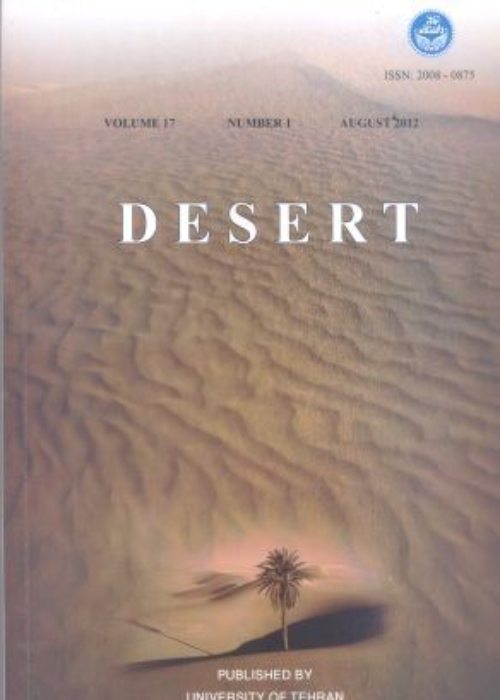Responses of above and below ground traits of 10 accessions of Triticum boeoticum to non-stress and imposed moisture stress conditions
Author(s):
Article Type:
Research/Original Article (دارای رتبه معتبر)
Abstract:
Triticum boeoticum wild wheat is a remarkable gene pool to environmental stress resistance. It is one of the most valuable species of the Triticeae tribe for improving wheat cultivars to moisture-stress. This research was carried out to assess the changes and responses of different traits of 10 accessions of Triticum boeoticum under non-stress and imposed moisture stress conditions in 2015 and 2016. Most traits were significantly affected by accession (A), water treatments (WT), and A×WT interactions. The accessions showed a high-level of genetic diversity for all traits, except peduncle weight. The accessions Tb5 and TB3 with the highest amount of economic yield per plant (EYPP) and water use efficiency (WUE), were less affected by the imposed moisture stress, while accession Tb6 with the maximum amount of water use (WU), main root length (MRL) and some phenological traits, were the most affected. The traits of WUE and main stem weight (MSTW) showed the highest and the traits of excised leaf water retention (ELWR), MRL and WU showed the lowest alignment with EYPP, respectively. The ability of producing assimilates (by increasing biological yield per plant and MSTW) and the ability of faster assimilates-remobilization into grains (by increasing harvest index and WUE), has been a neglected aspect of breeding wheat program under drought stress. In other words, the ability of a genotype to produce more assimilates and allocate it to grains (by increased BYPP and WUE, respectively) instead of belowground-traits, will result to increase EYPP. For example, the Tb6 ecotype, due to the allocation of more assimilates to underground parts, had little grain yield. While the traits of WUE, BYPP, seed number per main spike, seed weight per main spike (SWPMS) and main spike weight (MSPW) showed a positive and significant (P<0.01) correlation to EYPP, the traits of ELWR, MRL, day to heading and day to anthesis, had a negative and significant (P<0.05) correlation with yield. Generally, a high amount of WUE, MSTW, SWPMS, MSPW and peduncle weight; with a low amount of ELWR, phenological traits (except grain filling period), MRL, WU, and root to shoot dry weight ratio (RDWSDW) were suggested for the improvement of grain yield. SWPMS and MSPW were two main-components of grain yield in the favorite accessions (Tb5 and Tb3). Tb5 and Tb3 may have value for breeding wheat better adapted to moisture stress conditions in future.
Keywords:
Language:
English
Published:
Pages:
87 to 97
magiran.com/p2017440
دانلود و مطالعه متن این مقاله با یکی از روشهای زیر امکان پذیر است:
اشتراک شخصی
با عضویت و پرداخت آنلاین حق اشتراک یکساله به مبلغ 1,390,000ريال میتوانید 70 عنوان مطلب دانلود کنید!
اشتراک سازمانی
به کتابخانه دانشگاه یا محل کار خود پیشنهاد کنید تا اشتراک سازمانی این پایگاه را برای دسترسی نامحدود همه کاربران به متن مطالب تهیه نمایند!
توجه!
- حق عضویت دریافتی صرف حمایت از نشریات عضو و نگهداری، تکمیل و توسعه مگیران میشود.
- پرداخت حق اشتراک و دانلود مقالات اجازه بازنشر آن در سایر رسانههای چاپی و دیجیتال را به کاربر نمیدهد.
دسترسی سراسری کاربران دانشگاه پیام نور!
اعضای هیئت علمی و دانشجویان دانشگاه پیام نور در سراسر کشور، در صورت ثبت نام با ایمیل دانشگاهی، تا پایان فروردین ماه 1403 به مقالات سایت دسترسی خواهند داشت!
In order to view content subscription is required
Personal subscription
Subscribe magiran.com for 70 € euros via PayPal and download 70 articles during a year.
Organization subscription
Please contact us to subscribe your university or library for unlimited access!


